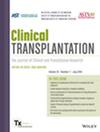Treating Donation After Circulatory Death Liver Grafts With Alteplase During Ex Situ Normothermic Machine Perfusion
Abstract
Introduction
Normothermic machine perfusion (NMP) is increasing the safe utilization of donation after circulatory death livers. Historically, tissue plasminogen activator (tPA) has been administered intraoperatively to DCD graft recipients to reduce non-anastomotic biliary complications (NAS). Treating the liver during NMP offers a potentially safer administration, preventing systemic treatment of the recipient. In this retrospective study, we explore our center's experience of giving tPA with FFP during NMP and its effects on clinical chemistries during perfusion, intraoperative transfusions, and post-operative outcomes and clinical chemistries.
Methods
One hundred and twenty-seven livers were perfused using the OrganOx metra, including 56 DCD livers (tPA + NMP-DCD) that received a bolus of 10 mg tPA followed by a 90-min infusion of 40 mg. Sixty-five livers from donation after brain death donors underwent NMP without tPA (NMP-DBD). A historical, propensity-matched cohort of 78 livers from non-NMP DCD donor livers (n = 51) were an additional comparator group (tPA-DCD).
Results
Intraoperative transfusions, 30-day and 3-month patient survival, and 30-day and 3-month graft survival were not statistically different between the tPA-NMP-DCD and NMP-DBD groups, except for cell saver volumes (p = 0.0034). Less platelets and cryoprecipitate transfusions were observed in the tPA-NMP-DCD livers compared to historical tPA-DCD livers (p = 0.0021 and 0.0046, respectively). One incidence of primary non-function occurred in the tPA-DCD group, and the tPA-NMP-DCD arm had one case of ischemic cholangiopathy required re-transplant. There was a higher reoperation rate for hematoma evacuation in the NMP-DBD cohort. Minimum follow-up time was 5 months.
Conclusion
Our results continue to lend support to NMP providing a platform for administering tPA to donor livers, curtailing a potential risk to the recipient.
Summary
Administration of tissue plasminogen activator (tPA) can be safely administered during normothermic machine perfusion. For centers who traditionally deploy tPA in recipients for DCD donor livers, delivering during NMP is an alternative safer option sparing the reciepient from exposure.

 求助内容:
求助内容: 应助结果提醒方式:
应助结果提醒方式:


